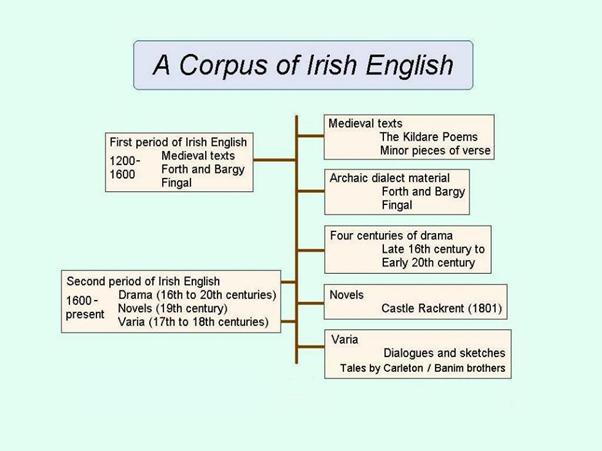Basic structure
(Source: project website http://www.uni-due.de/IERC/CIE.htm)
A Corpus of Irish English consists of over 70 texts with a time span of nearly 600 years. The material is arranged in a manner which reflects the main division in the history of Irish English into an earlier period, from the late 12th century to the end of the 16th century, and a later period, from the beginning of the 17th century to the present. The beginning of the first period is marked by the Norman invasion of 1169 and ends with the defeat of the Irish forces at the battle of Kinsale in 1601. After that date a renewed plantation of the country began with vigorous policies being applied throughout the 17th century which led to new forms of English being introduced, both to the north (from Lowland Scotland) and the south (from Western and North-Western England). There is a degree of continuity between the two periods in the east coast, above all in the city of Dublin. For the remainder of the country the English of the early modern period (17th century) formed the basis for later developments.
Sources of texts
There are basically two sources for the texts of A Corpus of Irish English. The first consists of Irish writers using English as their literary medium. This is the case with the Kildare Poems which represent the earliest attestations of Irish English. Whether these authors were native speakers of Irish, English or to some degree bilingual is uncertain. What is true is that they knew the form of English in Ireland from first hand. The second source consists of writers from outside Ireland, for all practical purposes from England, who chose to represent Irish English in their works, mainly with the aim literary parody, i.e. often within the context of the stage Irishman, a stock figure of fun in English drama.
As the documents stem from both Irish-born and English-born writers they represent a perspective from within and without so to speak. Linguistically this fact is particularly interesting as it tells us what features of earlier Irish English were salient and hence perceived by English authors concerned with imitating Irish speech in their writings. This situation applied from the time of Shakespeare until well into the 19th century and has to a certain extent not ceased to exist if one takes more modern media, apart from drama, into account.
Text types
The range of text types in the history of Irish English is impressive. It starts with poetry, the so-called Kildare Poems, a collection of 16 poems in the Harley 931 manuscript housed in the British Museum. There are glossaries for the dialect of Forth and Bargy from the late 18th and early 19th century. These are stored in A Corpus of Irish English as databases and can be transferred to text if you wish. The two remaining text types are 1) drama and 2) the novel. In the latter case one complete novel has been included, Castle Rackrent by Maria Edgeworth, because of its importance as the first regional novel in Britain and because in it the author represents the speech of the Irish population as we presume she would have heard it. The plays contained in the corpus cover a time span of some four centuries, starting with some pieces from the Elizabethan era, through the Restoration period and into the 19th and early 20th centuries. Given the speech basis of drama it plays a central role in the documentation of historical Irish English and is hence so amply represented in A Corpus of Irish English.

Figure 1. Text types in CIE
|

